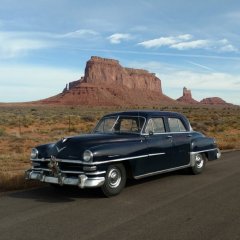Very interesting chain. I just read all of it. Wondering how things ever turned out for rb1949's poor transmission. I have the semi-automatic Fluid Torque Drive in my 1952 Saratoga. Last October I threw caution to the wind and drove the car from Michigan to Utah and back over a two week period of time. It was a fantastic 5,000 mile road-trip. From the beginning of the trip, the only way I could get the transmission to drop into low gear was to depress the clutch at a complete stop. That worked well enough and worked well enough for many years that I felt comfortable embarking on the trip. If I was close to a complete stop but still rolling and needed some faster acceleration, I'd just depress the clutch, throw it in low range, accelerate, and then go to high range. That system worked just fine. Toward the end of the trip and when I got home, the car was not wanting to shift into low when I would depress the clutch at a stand-still. I re-re-wired the wires that control the transmission operation with heavier gauge wires thinking that with a six volt system, the wires I had used previously just weren't a heavy enough gauge to deliver enough current to operate the solenoid. That effort made no difference at all. I then poked around with a multi-meter and decided that my governor was not doing it's job. I by-passed the governor and ran some wires into the passenger compartment that I connected to a simple switch. This by-pass switch allowed ME to be the governor. At speeds less than about 15 miles per hour, I would close the switch and the trans would down-shift just beautifully...without having to depress the clutch at a stand-still. That confirmed to me that my governor was bad. As luck would have it, I rummaged through my garage and actually found a New Old Stock governor on a shelf still in the box (my grandfather bought the car new and through the years he hoarded a small cache of extra parts. Thanks grandpa). Yesterday I installed the new governor and now the car shifts by itself like a dream. It's a wonderful driving experience.
So my question is this: Let's assume that rb1949 has a bad governor. Does anyone service these individual components? I can't find any for sale ANYWHERE. You CAN get around the governor with the switch-in-the-cockpit method that I used to verify my bad governor, but that's kind a nuisance. If my solenoid were acting up, then I'd be in a real pickle. Again, does anyone know anyone who services these parts or sells them? I'm guessing that a lot of these wonderfully overbuilt semi-automatic gearboxes get "resto-modded" only because of these two relatively simple electric components. Well, I found a part number on the box, 1370204, searched for "Chrysler part number 1370204" and may have just answered my own question...https://www.moparmall.com/1946-48-MoPar-UnderDrive-Transmission-Governor-p/869-090.htm. It looks like my governor but the applications listed on their website don't match my car. Hmm.
I guess I'm going to assume the electrical components that make these gearboxes function are getting hard to find.


